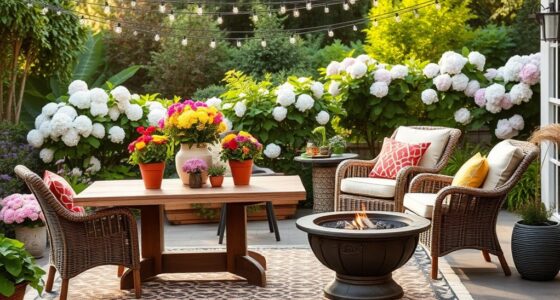To incorporate local art into your décor, start by choosing pieces that reflect your personal style and story, whether traditional textiles or contemporary works. Use focal points like gallery walls or prominent shelves to showcase your favorites, and blend styles thoughtfully for visual harmony. Support local artists at markets and exhibits to find unique pieces. If you keep exploring, you’ll discover even more ways to make your space uniquely yours.
Key Takeaways
- Select art that reflects your personal style and complements existing décor for authentic integration.
- Showcase local textiles and woven pieces as focal points or decorative accents to add cultural richness.
- Hang artwork at eye level in prominent areas, using lighting to highlight colors and details effectively.
- Mix traditional and contemporary pieces with a cohesive color palette to create visual contrast and harmony.
- Support local artists through markets and exhibitions to discover unique pieces that enhance your space.
Choosing Pieces That Reflect Your Style

When selecting local art for your décor, it is essential to choose pieces that genuinely resonate with your personal style. Think about the colors, themes, and moods that make you feel at home. Do you prefer bold, vibrant artwork or subtle, minimalist designs? Consider how each piece complements your existing décor and reflects your personality. It’s not just about supporting local artists; it’s about finding art that speaks to you. Trust your instincts and don’t feel pressured to follow trends. Your space should feel authentic and comfortable. Take your time exploring different styles and mediums. Additionally, exploring local art options can introduce unique textures and mediums that enrich your environment. Ultimately, selecting artwork that aligns with your taste ensures your décor feels cohesive and truly yours.
Displaying Art in Focal Points

Creating a focal point with your local art instantly draws attention and sets the tone for your entire space. Choose a prominent wall or area where the artwork can shine without distractions. Hang your piece at eye level to ensure it commands attention and feels natural within the room’s flow. Consider using lighting, like a spotlight or wall sconces, to highlight the artwork’s details and colors. Keep surrounding decor minimal so the art remains the star. If your space allows, create a gallery wall with several pieces, but ensure one piece is dominant. By thoughtfully placing your local art in a central, eye-catching spot, you’ll create a memorable visual anchor that celebrates your local culture and personal style. Hashtags play a crucial role in content discoverability to help your art reach a broader audience and enhance engagement.
Mixing Traditional and Contemporary Works

Mixing traditional and contemporary art can create a dynamic and engaging space. To do this well, you need to choose pieces that complement each other and highlight their differences. When done right, this approach emphasizes artistic contrast and adds depth to your décor. Being aware of retail hours can help you plan visits to galleries or stores that feature these works, ensuring a smooth shopping experience.
Harmonizing Styles Effectively
Blending traditional and contemporary art styles can add depth and character to your décor, but achieving a harmonious look requires intentionality. Start by balancing bold, modern pieces with more classic, detailed works to create visual interest without clutter. Use a consistent color palette to unify contrasting styles, ensuring they complement each other rather than compete. Consider the scale of each piece; mixing large, statement artworks with smaller, subtler pieces can help maintain balance. Placement is key—group similar styles together or space them thoughtfully across the room to avoid chaos. Keep the overall vibe cohesive by aligning textures and materials, like pairing sleek contemporary frames with ornate traditional ones. Being aware of interior design principles can help guide your choices for a more polished result. With careful curation, your space can seamlessly blend styles to reflect both tradition and modernity.
Selecting Complementary Pieces
To select complementary pieces that effectively combine traditional and contemporary works, focus on finding common ground in style, color, or theme. Look for artworks that share similar color palettes or design motifs, creating visual harmony despite differing origins. Consider pairing a modern sculpture with a classic painting that echoes similar themes or tones. Balance is key: choose one statement piece and support it with simpler, complementary items. Pay attention to scale; a large contemporary piece can anchor a room alongside smaller traditional works. Mixing textures and materials also helps bridge eras, making the space feel cohesive. Incorporating Vetted indoor gardening options like unique planters or water-efficient pots can further enhance the overall aesthetic and harmony of your space. Ultimately, your goal is to create a curated collection where each piece enhances the other, fostering a seamless dialogue between the old and new.
Highlighting Artistic Contrast
Building on the idea of selecting complementary pieces, highlighting artistic contrast involves intentionally pairing traditional and contemporary works to emphasize their differences. This technique creates visual interest and sparks conversation. To do this effectively:
- Place a classic, ornate frame around a sleek, modern artwork to highlight the contrast in style.
- Use bold colors of contemporary art against neutral, traditional backdrops for striking visual impact.
- Mix textures by pairing a vintage textile piece with a minimalist sculpture.
- Balance scale by displaying a large, abstract piece next to delicate, detailed traditional art.
- Consider the cultural heritage behind the pieces to add depth and meaningful dialogue to your décor.
Incorporating Textiles and Fabric Art

You can highlight local weaving techniques by framing or displaying fabric pieces prominently in your space. Choose authentic fabric items that reflect the region’s craftsmanship and cultural heritage. Incorporating these textiles adds both texture and a genuine sense of place to your décor. Exploring traditional weaving methods can further enrich your appreciation of local artistry.
Showcasing Local Weaving Techniques
Showcasing local weaving techniques brings vibrant textures and cultural stories into your décor, transforming plain spaces into authentic expressions of community identity. You can do this by:
- Displaying woven wall hangings that highlight traditional patterns and craftsmanship.
- Incorporating handwoven rugs as focal points in living areas or entryways.
- Using woven baskets or storage pieces to add texture and function.
- Framing small woven textiles as art pieces to celebrate local artistry.
- Carefully selecting natural fibers to enhance the authenticity and sustainability of your woven décor.
These elements not only add visual interest but also support artisans and preserve cultural heritage. By choosing authentic woven pieces, you bring a sense of history and community into your home. This approach creates a warm, textured environment that tells a story beyond mere decoration.
Selecting Authentic Fabric Pieces
Incorporating authentic fabric pieces into your décor instantly adds warmth, texture, and cultural depth to any space. When selecting textiles, look for pieces that reflect the local craftsmanship and traditions. Handwoven rugs, embroidered textiles, or vintage fabrics carry stories and authenticity that mass-produced items can’t match. Check the fabric’s origin, ensuring it’s genuine and ethically sourced. Pay attention to colors, patterns, and textures that resonate with the cultural context you want to showcase. Don’t be afraid to mix different textiles to create a layered, inviting look. Remember, the goal is to celebrate craftsmanship, so choose pieces that feel meaningful and authentic. Properly integrated, these fabrics become statement pieces that enhance your décor’s cultural richness. Additionally, incorporating vintage textiles can enhance the rustic charm characteristic of farmhouse design, blending cultural elements seamlessly into your space.
Creating a Gallery Wall of Local Artists

Creating a gallery wall featuring local artists is a vibrant way to celebrate the community’s creativity and add a personal touch to your space. Start by selecting a cohesive theme or color palette to unify diverse artworks. Next, choose a mix of frame styles and sizes for visual interest, but keep them consistent in tone. Arrange the pieces on the floor first to experiment with layout before hanging. Consider balancing larger and smaller artworks to create harmony. Finally, hang your gallery at eye level for ideal viewing and impact. Incorporate these steps to showcase local talent uniquely and meaningfully, transforming blank walls into a curated display of community artistry. Being aware of regional legal resources can also help you find local artists or galleries to support.
Using Art to Complement Your Color Scheme

When selecting artwork to display, consider how its colors can enhance or harmonize with your existing color scheme. If your room features neutral tones, choose art with bold, vibrant hues to create a focal point. Conversely, if your space already has strong colors, opt for artwork with softer shades or subtle contrasts to balance the look. Pay attention to the undertones in your walls and furniture, and select art that either complements or contrasts thoughtfully. You can also use artwork to introduce new colors that tie different elements together. Remember, the goal is to create visual harmony, so trust your instincts and experiment with different pieces until you find the perfect match that elevates your décor.
Supporting Artists Through Local Markets and Exhibits

Showcasing local artwork not only adds unique character to your décor but also supports the talented communities nearby. By engaging with local markets and exhibits, you directly contribute to artists’ growth and sustainability. Here are four ways to get involved:
Celebrating local art enriches your space and supports community creativity.
- Visit weekly markets to discover fresh pieces and connect with artists.
- Attend gallery openings to see new collections and learn their stories.
- Participate in art fairs to purchase work directly from creators.
- Volunteer or sponsor local exhibitions to help expand opportunities for artists.
These actions foster relationships, deepen your appreciation for local talent, and guarantee your décor reflects your community’s creative spirit. Supporting artists through these channels creates a vibrant, authentic environment in your home and promotes a thriving local art scene.
Maintaining and Caring for Your Art Collection

Proper maintenance is essential to preserve the beauty and value of your art collection over time. You should regularly dust your artworks with a soft, lint-free cloth and keep them out of direct sunlight to prevent fading. Humidity and temperature fluctuations can damage pieces, so aim for stable, moderate conditions. Handle artworks by their edges to avoid fingerprints and accidental damage. Use appropriate framing and glass to protect against dust and UV rays. The table below highlights key care elements:
| Cleaning & Handling | Environmental Control | Display & Storage |
|---|---|---|
| Dust gently regularly | Keep humidity around 50% | Hang artworks securely |
| Avoid using chemicals | Maintain consistent temperature | Use acid-free materials |
| Handle with clean hands | Keep away from sunlight | Rotate collections periodically |
Frequently Asked Questions
How Can I Authenticate the Provenance of Local Artwork?
To authenticate the provenance of local artwork, you should start by researching the artist’s background and exhibition history. Verify signatures, labels, or certificates of authenticity, and consult reputable galleries or art experts familiar with local art scenes. Keep records of purchase receipts, provenance documents, and any correspondence. Visiting local museums or archives can also provide valuable context. These steps help guarantee your artwork’s legitimacy and value.
What Budget Options Exist for Acquiring Local Art?
You might think acquiring art costs a fortune, but there are budget-friendly options that surprise you! You can attend local art fairs, visit community centers, or explore online platforms that showcase emerging artists’ work at affordable prices. Thrift stores and art swaps are treasure troves for unique finds. By being patient and flexible, you’ll discover incredible local pieces without breaking the bank, making your space truly special and authentic.
How Do I Choose Art That Suits Small Spaces?
When choosing art for small spaces, you should focus on pieces that complement your room’s size and style. Opt for smaller or medium-sized artwork that won’t overwhelm the area. Look for pieces with light colors or simple designs to create a sense of openness. Hang art at eye level, and consider framing or grouping smaller pieces to add visual interest without cluttering. Your goal is to enhance the space without overpowering it.
Are There Seasonal or Cultural Considerations When Selecting Art?
You might find it interesting that seasonal and cultural considerations truly enhance your space. When selecting art, think about the time of year or cultural events happening around you. For instance, during holidays, festive artwork adds warmth, while cultural pieces celebrate your heritage. By aligning your choices with these moments, you create a vibrant, meaningful environment that resonates personally and reflects the world outside your door.
How Can I Collaborate With Artists for Custom Pieces?
To collaborate with artists for custom pieces, start by researching local talent whose style aligns with your vision. Reach out directly or attend art events and exhibitions to make genuine connections. Be clear about your ideas, budget, and timeline, and remain open to their creative input. Building a respectful, collaborative relationship guarantees you get unique, personalized artwork that enhances your space and supports the local art community.
Conclusion
Just like Van Gogh’s timeless masterpieces, your local art tells a unique story that enriches your space. By thoughtfully selecting and caring for these pieces, you turn your home into a gallery that celebrates community and creativity. Remember, every piece you display is a brushstroke in your personal masterpiece—your home’s story. Embrace the journey of incorporating local art, and let your space become a reflection of your vibrant, artistic soul.









